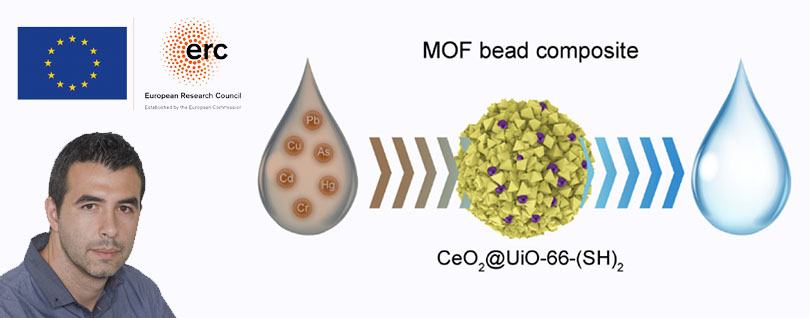Researchers of the ICN2 Supramolecular NanoChemistry and Materials group and of the ICN2 Inorganic Nanoparticles group have designed, synthetized and tested microbeads, based on a combination of Metal-Organic Frameworks materials and inorganic nanoparticles, that are able to simultaneously remove multiple heavy metals from polluted water.

Contamination of water by heavy metals is a critical environmental and health problem whose impact is especially severe in developing countries. Toxic waste produced in industrial processes is often dumped into rivers, causing human exposition to very dangerous substances, among which heavy metals such as arsenic, cadmium, chromium, lead and mercury.
Various techniques to purify water have been developed, including coagulation, filtration, chemical precipitation and adsorption. The most effective, efficient and versatile method among these has proven to be adsorption, with activated carbon, zeolites, clay minerals and natural fibers being the most commonly used adsorbents. A study carried out by Gerard Boix, Dr Inhar Imaz and group leader ICREA Prof. Daniel Maspoch, of the ICN2 Supramolecular NanoChemistry and Materials group, as well as Dr Neus Bastus and group leader ICREA Prof. Victor Puntes, of the ICN2 Inorganic Nanoparticles group, and recently published in ACS Applied Materials & Interfaces, demonstrates that by combining Metal-Organic Frameworks (MOFs) and inorganic nanoparticles (iNOs) into composite materials it is possible to simultaneously remove many different pollutants from water.
MOFs are porous materials that show high adsorption capacity and chemical and structural tunability. Inorganic particles, in turn, exhibit high activity and specificity towards heavy-metal ions. By integrating materials from these two classes, a single composite with a broad-spectrum activity can be synthetized. Spherical microbeads of this composite (called iNP@MOF-Beads) were produced at the ICN2 via a one-step spray-drying process, using CeO2 as iNP and UiO-66 as MOF to obtain CeO2@ UiO-66-(SH)2. This one-step method, which reduce drastically the reaction times and allow higher cost-effectiveness of the process, was developed by Prof. Maspoch’s group and is protected by an ICN2 patent.
As a proof-of-concept, these microbeads were tested on lab-created samples reproducing the water composition of two of the most polluted rivers in the world (the Buringara River in Bangladesh and the Bone River in Indonesia), both of which contain metal ions at concentrations well-above the standards fixed by the WHO. The adsorbent material under test was able to reduce remarkably the concentration of cadmium, chromium, copper, lead, mercury and arsenic in the samples. The composite microbeads were also tested for purification of a real field sample by using water collected from the Sarno River in Italy. The concentrations of metal ions in this river are compatible with the WHO standards for potable water, nevertheless it shows levels of chromium higher than those of many other European rivers. The microbeads proved to be efficient on this real sample as well.
Finally, the authors of this study investigated the possibility to provide magnetism properties to their composite beads to be able to magnetically remove them from water after purification. Thus, CeO2 and Fe3O4 nanoparticles were simultaneously incorporated into UiO-66-(SH)2 to produce magnetically responsive microbeads. These showed to be as able to adsorb heavy metals as the original non-magnetic microbeads and, in addition, they could be easily removed from the treated water with a magnet.
This work represents the major result of a project lead by Prof. Maspoch and funded by a European Research Council (ERC) Consolidator grant, as well as the cornerstone of a new project, called HYBEAD, which was assigned an ERC Proof of Concept grant in May 2019. Thanks to this second round of funding, Prof. Maspoch and his team will be able to bring to the market the iNP@MOF-Beads for actual application to polluted water purification.
Reference article:
Gerard Boix, Javier Troyano, Luis Garzón-Tovar, Ceren Camur, Natalia Bermejo, Amirali Yazdi, Jordi Piella, Neus G. Bastus, Victor F. Puntes, Inhar Imaz and Daniel Maspoch, MOF-Beads Containing Inorganic Nanoparticles for the Simultaneous Removal of Multiple Heavy Metals from Water, ACS Appl. Mater. Interfaces 2020, 12, 9, 10554-10562, DOI: 10.1021/acsami.9b23206

